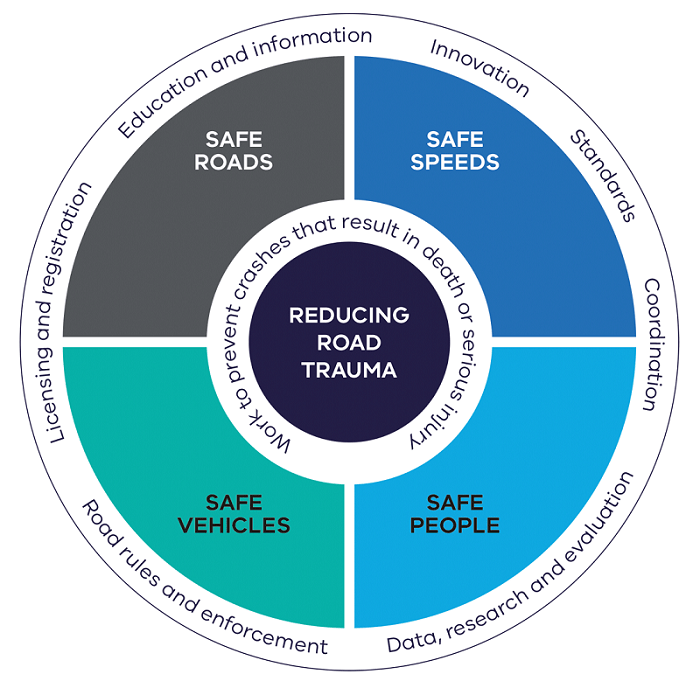For most Victorians, being on or near our road network is part of everyday life – as drivers or passengers, riders, cyclists, pedestrians, or users of public transport.
Crashes can happen to anyone, anywhere and anytime. It’s our collective responsibility to make sure our roads are safe for everyone.
The Victorian Road Safety Strategy 2021–2030 sets out the vision of zero road deaths by 2050 with the
following objectives:
- Ensure all Victorians are safe and feel safe on and around our roads.
- Halve road deaths and progressively reduce serious injuries by 2030.
- Embed a culture of road safety within the Victorian community.
- Deliver a suite of initiatives that are achievable and have an impact in the short term, but also prepare Victoria for the future.
We’re delivering the strategy in three Action Plans. This approach allows us to adapt to changes in knowledge, the environment and the community over time.
We believe deaths and serious injuries on our roads are preventable, which is why we’re working to reduce the risk and severity of crashes, while creating a culture of safety for all Victorian road users.
To change the future, we need to be working hard today. This is why the second of three Action Plans builds on the progress of the first plan and establishes the groundwork for further effort in the third plan.
Benefits beyond road safety
Being and feeling safe on and around our roads improves our quality of life and liveability within our communities.
Safer roads and roadsides support the independence of our most vulnerable citizens, so they can move safely while they are walking, using micromobility or other mobility aids, and moving to and from public transport.
Safer movement through local urban areas encourages participation in local economies.
Active transport has benefits for our physical and mental health, and safer roads and roadsides encourage more people to walk and ride for both transport and leisure.
Safer roads enable smoother and more reliable journeys. This benefits commuters, supply chains, improves fuel economy and reduces emission
Victorian Road Safety Partners
This plan has been developed by the Victorian Road Safety Partners, who will act collectively to deliver its actions.
Each of the Partners focuses on different but complementary aspects of road safety:
- Road Safety Victoria at the Department of Transport and Planning leads the efforts of all road safety partners and leads the development and coordination of strategy, policy, programs and projects, working collaboratively with Road Safety Partners.
- The Transport Accident Commission (TAC) is a Victorian Government insurance agency that supports people injured in transport accidents, regardless of fault. The TAC plays a key role in promoting road safety through research, programs, campaigns, awareness raising and communications. The TAC invests in initiatives that effectively prevent road trauma.
- Compliance and enforcement support the regulation and operation of the network, with Victoria Police providing an active and visible police presence and enforcing unlawful behaviours, and the Department of Justice and Community Safety managing the Road Safety Camera Program and administration of judicial compliance.
- The Department of Health supports public health priorities, including prevention of injury and creating environments that promote physical and mental health, as well as the first response, medical and rehabilitation care for crash survivors.
We’ll continue to work closely with other partners and stakeholders, including local government road managers, peak bodies and communities, to help us achieve our goals.
In developing this Action Plan, the Partners have considered a significant data and evidence base and inputs from Australian and international road safety experts. Our approach is in line with the internationally recognised Safe System approach to road safety, which requires a collective and coordinated response from various perspectives to reduce road safety risk.
The Safe System
The internationally recognised Safe System approach to road safety considers the network as a system of interactions between the road itself, people, vehicles and speeds.
The Safe System recognises that people will make mistakes and may have road crashes – but that crashes should not result in death or serious injury.
With that in mind, roads, speeds and vehicles should be designed to avoid crashes and to reduce the impact when they do.
The Safe System advocates for shared responsibility when it comes to safety on our roads – of those who design and manage the network, as well as those who use it.
We achieve a Safe System through:
- Safe roads
- Design, operation and maintenance of the road and roadside to reduce likelihood and severity of crashes.
- Safe vehicles
- Safety features and technology in vehicles to limit the likelihood and severity of crashes.
- Safe speeds
- Speed limits compliance and physical constraints resulting in safer speeds to limit the likelihood and severity of crashes.
- Safe people
- Road user behaviour, including licensing, education, enforcement and personalsafety equipment.
"Road trauma does not discriminate"
Updated
